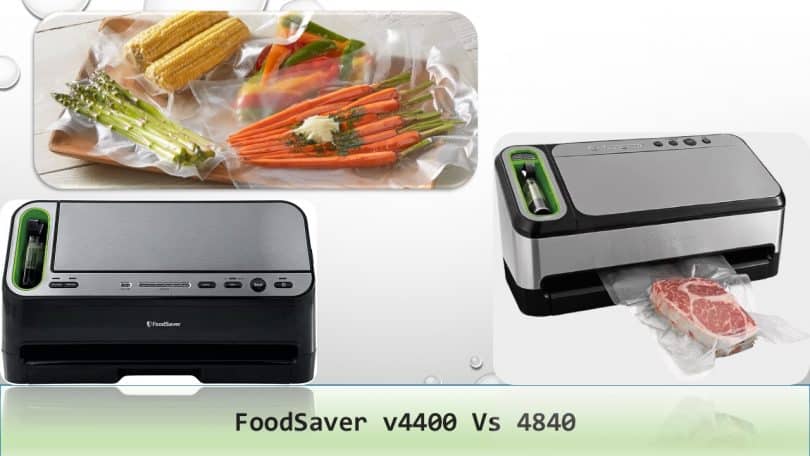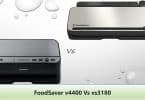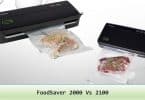As a professional chef, I understand the importance of food freshness. Whether I’m cooking for myself or my family, I want to ensure that the ingredients I use are as fresh as possible. That’s why I was excited to try out a food vacuum sealer. These devices allow you to vacuum-seal your food in airtight bags, which helps keep it fresh for longer periods of time.
I was particularly interested in using the vacuum sealer to store meat and fish. According to some studies, vacuum-sealed meat can stay fresh for up to 3 years, compared to just three or four days if it isn’t sealed. And because the bags used by these machines are airtight, they also help prevent freezer burn.
If you are looking for a new food vacuum sealer, FoodSaver v4400 vs 4840 comparison will guide you through the process of choosing the one suitable to your needs. Let’s explore amazing features of these powerful vacuum sealers to find out the best for your kitchen.
FoodSaver V4400 Vs 4840 Comparison Chart
Feature FoodSaver V4400 FoodSaver 4840
Dimensions 11x20x12 Inches 9.5x19x10.6 Inches
Material Plastic Plastic
Weight 10 lbs 10 lbs
Color Silver/Black Silver/Black
Control Panel Buttons Buttons
Automatic Bag Detection Yes Yes
Starter Kit Yes Yes
Built in Roll Storge Yes Yes
Bag Cutter Yes Yes
Automatic Moisture Detection Yes Yes
Drip Tray Yes Yes
Cleanup Dishwasher Safe Dishwasher Safe
Handheld Sealer Yes Yes
Included Items (1) 11x10 Inch Roll (1) 11x10 Inch Roll
(3) 1 Quart Bags (3) 1 Quart Bags
(2) 1 Gallon Bags (2) 1 Gallon Bags
(3) 1 Quart Zipper Bags (3) 1 Quart Zipper Bags
(2) 1 Gallon Zipper Bags (2) 1 Gallon Zipper Bags
Used for Meals, Fruits, Vegetables, Herbs, Leftovers, Meat, and more Meals, Fruits, Vegetables, Herbs, Leftovers, Meat, and more
Warranty 5 Years Limited Warranty 5 Years Limited Warranty
User Rating 4.7/5 Star 4.7/5 Star
Check Best Price Buy on Amazon Buy on Amazon
What is the Difference Between FoodSaver V4400 Vs 4840?
FoodSaver V4400 vs 4840 are two affordable vacuum sealers for home use. They are neither premium quality commercial vacuum sealers nor too cheap to break down the next day but If maintained well, they could last for years without breaking down.
Both vacuum sealers offer impeccable sealing performance without lags. The only difference between the two is the placement of controls. FoodSaver v4400 has its controls at the front side on the top whereas FoodSaver 4840 has all the controls at the father end on the top.
Secondly, apart from slight difference in dimensions which we will discuss in next section, there is huge difference in price of the two vacuum sealers. FoodSaver v4400 costs about 200$ whereas FoodSaver 4840 costs about 250$ which is a significant difference if you have budgetary issues.
Similarities: FoodSaver V4400 vs 4840
To preserve the freshness, seal in the flavor and save your food from freezer burn, FoodSaver v4400 and 4840 are some of the most wanted food vacuum sealers for domestic use on the market that you can find today.
Both vacuum sealers have achieved incredible 4.7/5 star rating on Amazon from thousands of users across the world out of which about 93% are extremely satisfied and content with the performance of the vacuum sealers.
Construction & Design
Out of the box, FoodSaver v4400 and 4840 give a good first impression. Both models feature a durable outer shell made out of dense plastic. Silver top and black base gives it a premium look while controls are arranged in an intuitive sequence for anybody to understand it without being intimidated.
The top cover opens to a chamber where you store plastic roll and also it houses the built-in cutter which lets you cut the plastic roll to the required size.
FoodSaver v4400 measures 11x20x12 Inches whereas FoodSaver 4840 measures 9.5x19x10.6 Inches which is just about an inch smaller than the former. Both models weigh 10 pounds but felt lighter as we unboxed.
On the left side of the vacuum sealers, you can find the handheld sealer for zipper bags jars. Overall, FoodSaver v4400 vs 4840 are loaded with great features to fulfil all your food preservation needs.
Features
As we said, FoodSaver v4400 and 4840 are packed with some great features that we can make good use of. Here is the full list of features that you will experience while using either of the two models.
- Both FoodSaver v4400 and 4840 feature automatic bag detection mechanism.
- Both vacuum sealers have automatic moisture detection capability.
- There is a drip tray included which is also dishwasher safe.
- Both models come with a handheld vacuum sealer.
- Both models come with a starter kit that includes (1) 11×10 Inch Roll, (3) 1 Quart Bags, (2) 1 Gallon Bags, (3) 1 Quart Zipper Bags, and (2) 1 Gallon Zipper Bags.
- You can use either of the vacuum sealers to seal meals, fruits, vegetables, herbs, leftovers, meat and much more and it will enhance the shelf life of your ingredients by many folds.
- Both vacuum sealers are backed by 5 years of limited warranty.
Quick Overview of FoodSaver V4400 2-in-1 Vacuum Sealer
- Seal freshness in: Meat preserved with the FoodSaver system in the freezer can last up to 3 years and still taste fresh, flavorful, and freezer burn free; Prep ahead meals, leftovers, and produce stored in the fridge will stay fresh up to weeks later instead of spoiling in days.Includes: (1) 11""x10' vacuum seal roll (3) 1-quart vacuum seal bags (2) 1-gallon vacuum seal bags (3) 1-quart vacuum zipper bags (2) 1-gallon zipper bags
- Automatic bag detection: Automatic bag detection makes vacuum sealing easier than ever: Simply put the bag in the vacuum chamber and the machine does the rest to ensure your food stays fresh and flavorful
The Good √
- Compact and portable
- Suitable for domestic use
- Included a starter kit
- Dishwasher safe drip tray
- Automatic bag detection
- Automatic moisture detection
- Quick sealing process
The Bad ×
- Noisy
- Issues with sealing
Quick Overview of FoodSaver 4840 Vacuum Sealer Machine
- Keep food fresh in the freezer up to 5x longer and in the fridge or pantry up to 2x longer, compared to ordinary storage methods.Cord Length (IN): 30
- Automatic bag detection and vacuum sealing means two quick and easy steps to seal and save
The Good √
- Easy to navigate control panel
- Handheld vacuum sealer hose
- Dishwasher safe drip tray
- Plastic roll storage
- Built-in cutter
- Quick sealing
The Bad ×
- Makes noise
- Expensive
Conclusion: FoodSaver v4400 vs 4840 Vacuum sealer
If you’re a serious home cook, a food vacuum sealer is an indispensable kitchen tool. A vacuum sealer removes all the air from a sealed bag or container, which has two major benefits. First, it helps preserve food by preventing oxidation and bacteria growth. Second, it allows you to compress food, so you can fit more into your freezer or pantry.
FoodSaver v4400 vs 4840 are two of the finest and most affordable models available for domestic use. If you are looking for a budget-friendly vacuum sealer, FoodSaver v4400 should do. In case you could spend a few extra bucks, FoodSaver 4840 can be your first option however, we recommend choosing v4400 because why spend extra when you can have similar performance in less price.
What would you choose and why? Let us know if this comparison has helped you choose what you were looking for.
Other Comparisons: FoodSaver v4400 vs vs3180 | FoodSaver 2000 Vs 2100
What Should You Not Vacuum Seal?
Vacuum sealing is an excellent way to preserve food and extend its shelf life. However, there are some items that should not be vacuum sealed due to safety or quality concerns. In this section, we will provide you with a list of items that you should not vacuum seal.
- Raw mushrooms
Raw mushrooms contain a high level of moisture, which can cause them to spoil quickly if vacuum sealed. Instead, store them in a paper bag or a breathable container.
- Soft fruits and vegetables
Soft fruits and vegetables like strawberries, raspberries, and lettuce are easily crushed by the vacuum sealing process, which can damage their texture and quality. Instead, store them in airtight containers or bags.
- Bread
Vacuum sealing bread can cause it to lose its texture and become stale quickly. Instead, store bread in a bread box or airtight container.
- Garlic and onions
Garlic and onions release gases that can cause the vacuum-sealed bags to inflate and potentially break the seal. Store them in a cool, dry place instead.
- Foods with high fat content
Foods with high-fat content, such as cheese and fatty meats, can go rancid quickly when vacuum sealed due to the lack of oxygen. Instead, wrap them tightly in parchment paper and store them in airtight containers or bags.
- Foods with strong odors
Vacuum sealing foods with strong odors, such as fish or blue cheese, can cause the odors to linger in the vacuum sealer and transfer to other foods. Instead, store them in airtight containers or bags.
- Carbonated beverages
Vacuum sealing carbonated beverages can cause them to lose their carbonation and go flat. Instead, store them in their original containers with the cap tightly sealed.
In conclusion, while vacuum sealing is an excellent way to preserve food, there are some items that should not be vacuum sealed due to safety or quality concerns. By following these guidelines, you can ensure that your food stays fresh and safe to eat.



